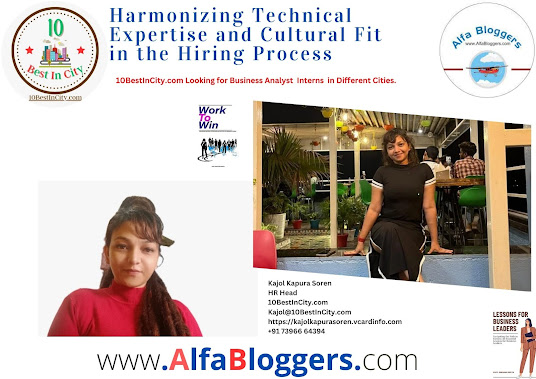Harmonizing Technical Expertise and Cultural Fit in the Hiring Process
Striking the Perfect Balance: Harmonizing Technical Expertise and Cultural Fit in the Hiring Process
In the ever-shifting landscape of contemporary workplaces, the timeless question of striking an optimal equilibrium between technical expertise and cultural fit in the context of recruitment remains as pertinent as ever. As organizations relentlessly pursue success, they are progressively realizing that a seamless fusion of these two elements is imperative for constructing high-achieving teams and nurturing a flourishing work milieu. This comprehensive article delves deep into the pivotal importance of upholding a delicate equilibrium between technical proficiency and cultural congruence during the intricate hiring process. It further furnishes pragmatic insights to ensure that your organization harnesses the paramount advantages from both ends of the spectrum.
The Vitality of Technical Expertise:
Undoubtedly, technical proficiency constitutes the bedrock of any progressive organization. A cadre armed with the apt skills and knowledge possesses the capability to furnish effective solutions, pioneer innovations, and steer the enterprise toward unprecedented heights. In a world propelled by technology, securing the services of adept technical minds is non-negotiable. Nevertheless, directing exclusive attention to technical prowess may inadvertently engender a monolithic work culture that fails to acknowledge the holistic attributes that contribute to the dynamics of a team and the overarching triumph of the organization.
The Essence of Cultural Fit:
The nebulous concept of cultural fit, a significant facet in recruitment, revolves around shared values, convictions, and outlooks that resonate harmoniously with an organization's fundamental identity. Employees who seamlessly align with the company's cultural fabric tend to exhibit heightened engagement levels, foster collaboration, and display remarkable adaptability. They contribute not only to task accomplishment but also to cultivating an atmosphere conducive to positive work dynamics. However, an undue emphasis on cultural alignment could potentially stifle diversity and curb novel perspectives that are often the sparks igniting innovation.
Strategies for Synergizing Both:
Precise Definition of Criteria: It is imperative to craft meticulously detailed job descriptions and specifications that delineate the indispensable technical competencies. Concurrently, articulate the cultural values and behaviors that define the essence of your organization. This proactive step empowers candidates to grasp the expectations right from the outset.
Structured Interview Methodologies:
Devising interview processes that encompass both technical evaluations and behavioral inquiries aligned with cultural compatibility is vital. Assessing candidates based on their expertise alongside their approach toward challenges, teamwork, and adaptability is crucial.
Diversity-Enriched Interview Panels: Incorporating a diverse ensemble of interviewers encompassing various departments and hierarchical levels is pivotal. This measure serves to thwart biases and ensures a comprehensive evaluation of a candidate's compatibility not only with technical prerequisites but also with cultural subtleties.
Real-World Scenario Assessments:
Presenting candidates with real-life scenarios mirroring potential on-the-job challenges serves to unearth their troubleshooting acumen, technical prowess, and their ability to navigate situations congruent with the company's cultural ethos.
Holistic Onboarding and Seamless Integration: Post-selection, investing in a robust onboarding process is indispensable. This process should encompass not only technical training but also a comprehensive initiation into the organization's mission, values, and collaborative practices. Such an assimilation journey aids new hires in comprehending and embracing the cultural tapestry of the company.
A Continual Feedback Ecosystem:
Cultivating a culture of open communication, where employees are encouraged to proffer feedback pertaining to technical protocols as well as cultural dynamics, forms the bedrock of ongoing growth. This practice ensures that any disparities are expediently identified and rectified.
The juxtaposition of technical prowess and cultural compatibility has perennially perplexed organizations that aspire to attain excellence. As the business milieu evolves, it becomes evident that the key to resolving this conundrum lies in attaining equilibrium between these two realms. The seamless amalgamation of technical virtuosity and cultural resonance is poised to engender teams that not only deliver exceptional outcomes but also foster an environment characterized by inclusivity, innovation, and collaboration. By diligently adhering to the strategies elucidated above, organizations can pave the path for a future wherein technical brilliance and cultural harmonization coexist synergistically.
Complementary Hashtags for Your LinkedIn Discourse on Balancing Technical Proficiency and Cultural Alignment in Recruitment:
#HiringStrategies, #TeamBuilding, #CulturalFit, #TechnicalExpertise, #WorkplaceCulture, #TalentAcquisition, #DiversityAndInclusion #HumanResources #EmployeeEngagement #InnovationInHiring #ModernWorkplace #BalancedHiring #LeadershipInsights #EmployeeOnboarding #CollaborativeTeams #FutureOfWork #PeopleStrategy #RecruitmentTips #CulturalAlignment #SuccessThroughPeople #HiringBestPractices
#HiringStrategies #TeamBuilding #CulturalFit #TechnicalExpertise #WorkplaceCulture #TalentAcquisition #DiversityAndInclusion #HumanResources #EmployeeEngagement #InnovationInHiring #ModernWorkplace #BalancedHiring #LeadershipInsights #EmployeeOnboarding #CollaborativeTeams #FutureOfWork #PeopleStrategy #RecruitmentTips #CulturalAlignment #SuccessThroughPeople #HiringBestPractices



